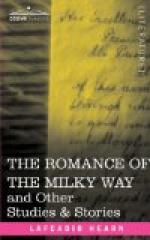Mi wa koko ni;
Tama wa otoko ni
So[:i]n[’e] suru;—
Kokoro mo shiraga
Haha ga kaih[=o].
[Here her body lies; but
her soul is far away, asleep in the
arms of a man;—and
the white-haired mother, little knowing
her daughter’s heart,
is nursing (only the body).[30]]
[Footnote 30: There is a double meaning, suggested rather than expressed, in the fourth line. The word shiraga, “white-hair,” suggests shirazu, “not knowing.”]
Tamakushig[’e]
Futatsu no sugata
Mis[’e]nuru wa,
Awas[’e]-kagami no
Kag[’e] no wazurai.
[If, when seated before her toilet-stand, she sees two faces reflected in her mirror,—that might be caused by the mirror doubling itself under the influence of the Shadow-Sickness.[31]]
[Footnote 31: There is in this poem a multiplicity of suggestion impossible to render in translation. While making her toilet, the Japanese woman uses two mirrors (awas[’e]-kagami)—one of which, a hand-mirror, serves to show her the appearance of the back part of her coiffure, by reflecting it into the larger stationary mirror. But in this case of Rikomby[=o], the woman sees more than her face and the back of her head in the larger mirror: she sees her own double. The verses indicate that one of the mirrors may have caught the Shadow-Sickness, and doubled itself. And there is a further suggestion of the ghostly sympathy said to exist between a mirror and the soul of its possessor.]
III. [=O]-GAMA
In the old Chinese and Japanese literature the toad is credited with supernatural capacities,—such as the power to call down clouds, the power to make rain, the power to exhale from its mouth a magical mist which creates the most beautiful illusions. Some toads are good spirits,—friends of holy men; and in Japanese art a famous Rishi called “Gama-Sennin” (Toad Rishi) is usually represented with a white toad resting upon his shoulder, or squatting beside him. Some toads are evil goblins, and create phantasms for the purpose of luring men to destruction. A typical story about a creature of this class will be found in my “Kott[=o],” entitled “The Story of Chug[=o]r[=o].”
M[’e] wa kagami,
Kuchi wa tarai no
Hodo ni aku:
Gama mo k[’e]sh[=o] no
Mono to kos[=o] shir[’e].
[The eye of it, widely open, like a (round) mirror; the mouth of it opening like a wash-basin—by these things you may know that the Toad is a goblin-thing (or, that the Toad is a toilet article).[32]]
[Footnote 32: There are two Japanese words, kesh[=o], which in kana are written alike and pronounced alike, though represented by very different Chinese characters. As written in kana, the term kesh[=o]-no-mono may signify either “toilet articles” or “a monstrous being,” “a goblin.”]




